Only verified editors can see this information.
CHOO BA'AK • The Mayan bone cleaning ritual in Pomuch, Mexico.
Story Date: Oct 26, 2022
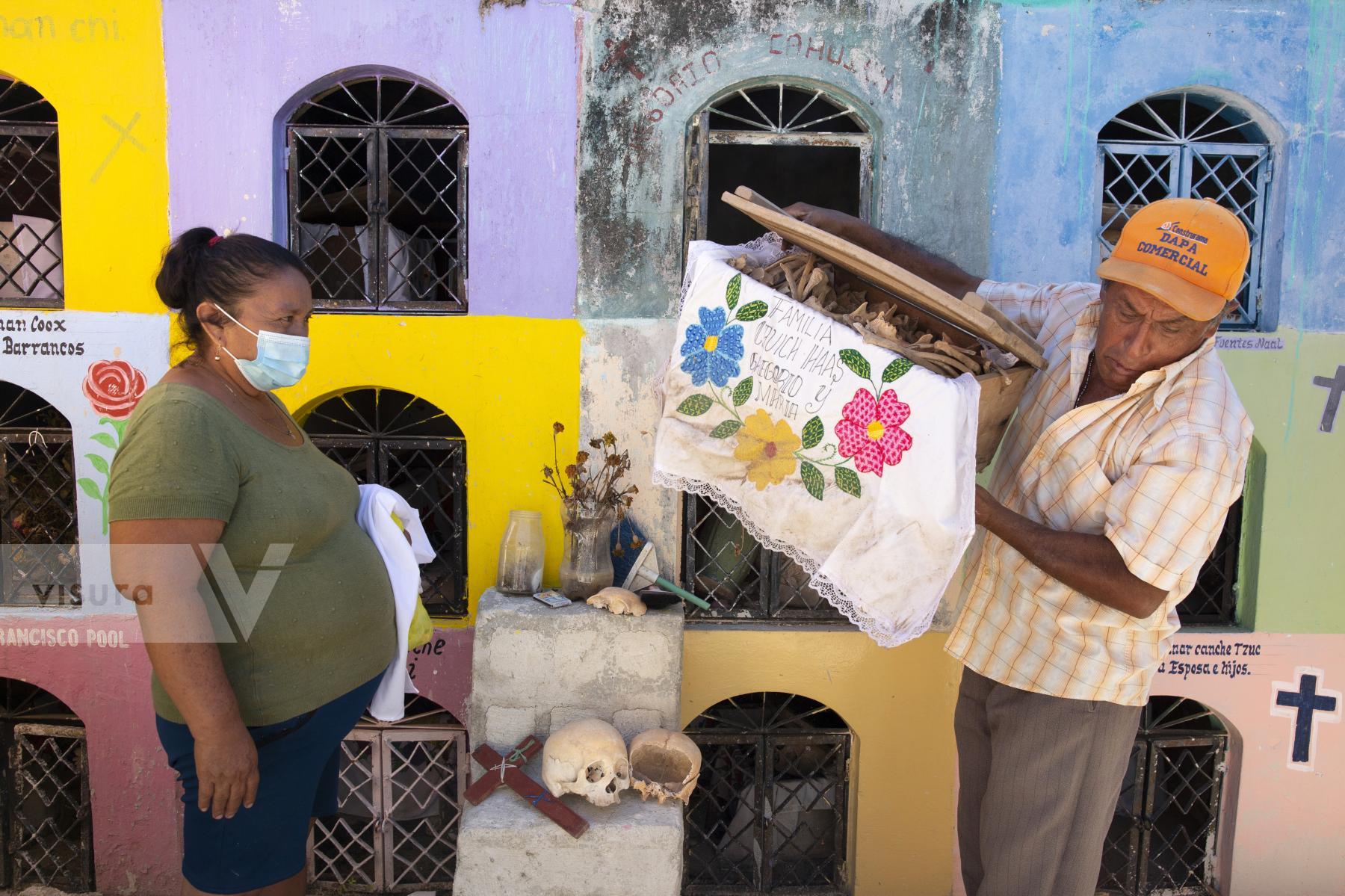
Caption:
Don Venancio Tuz Chi, one of the administrators of the Pomuch cemetery, pulling a box with the remains of two deceased relatives of the Cauich Haas family at the cemetery of Pomuch, Campeche state, Mexico on October 22, 2022. Don Venancio has been a hired bone cleaner for over twenty years, he is paid $1.50 per skeleton. Every year in preparation for Hanal Pixán, the Mayan Day of the Dead celebration, members of the Pomuch community in southeastern Mexico extract bones from their niches and carefully clean them – an ancestral tradition seen as a gesture of love and a way to get closer to deceased family members. This ritual, which in Mayan is known as Choo Ba’ak, can be done for the first time when a person has been dead for three years. Pomuch and a handful of other Mayan communities are believed to be the only places in the country where people clean the bones of the dead. Since 2017 this tradition is considered Cultural Heritage of the State of Campeche. Photograph by Bénédicte Desrus Pomuch Mexico
Don Venancio Tuz Chi, one of the administrators of the Pomuch cemetery, pulling a box with the remains of two deceased relatives of the Cauich Haas family at the cemetery of Pomuch, Campeche state, Mexico on October 22, 2022. Don Venancio has been a hired bone cleaner for over twenty years, he is paid $1.50 per skeleton. Every year in preparation for Hanal Pixán, the Mayan Day of the Dead celebration, members of the Pomuch community in southeastern Mexico extract bones from their niches and carefully clean them – an ancestral tradition seen as a gesture of love and a way to get closer to deceased family members. This ritual, which in Mayan is known as Choo Ba’ak, can be done for the first time when a person has been dead for three years. Pomuch and a handful of other Mayan communities are believed to be the only places in the country where people clean the bones of the dead. Since 2017 this tradition is considered Cultural Heritage of the State of Campeche. Photograph by Bénédicte Desrus Pomuch Mexico
Size: 3333h x 5000w
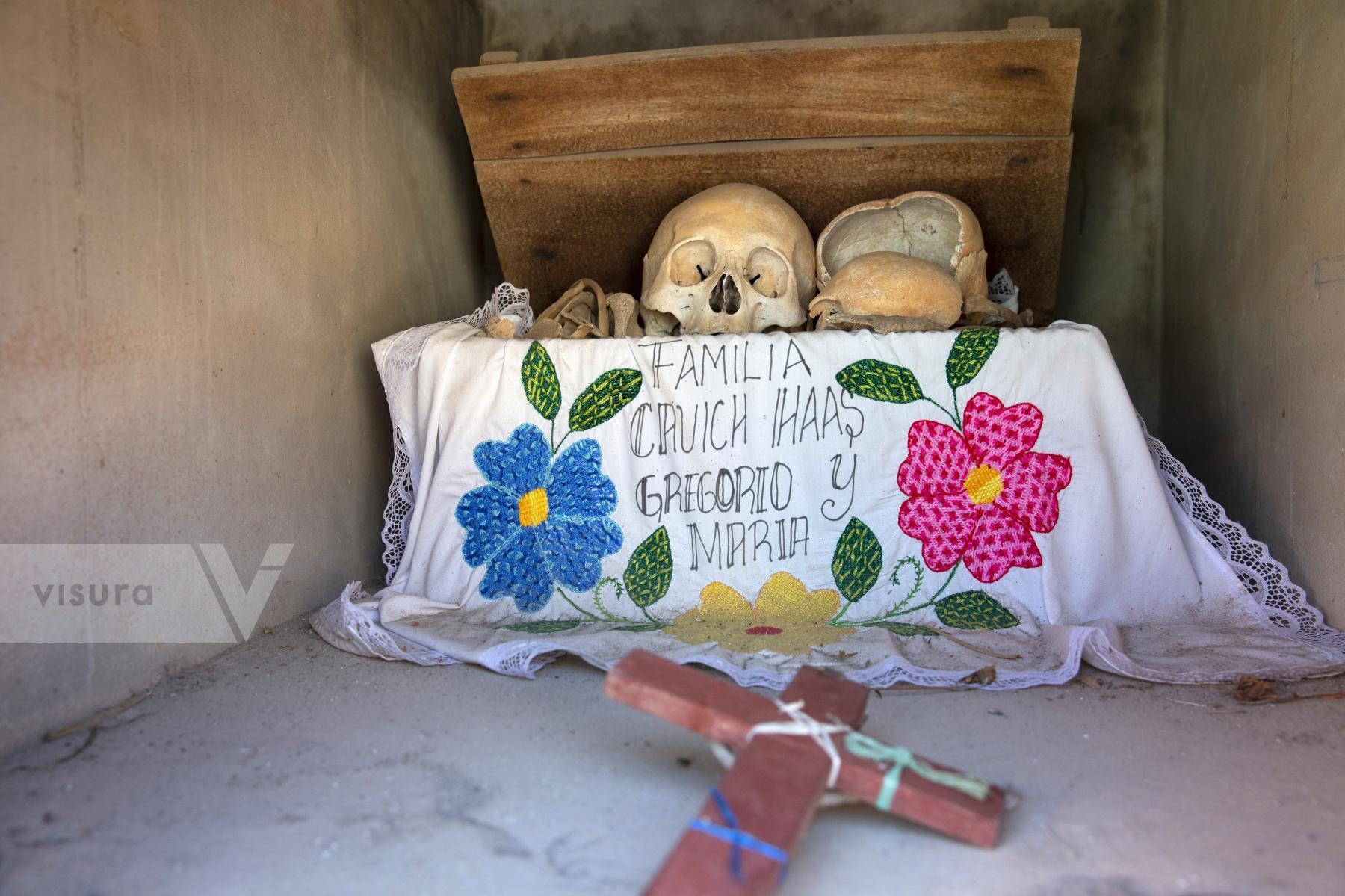
Caption:
Dried-up skulls and bones are seen wrapped in embroidered white tablecloths bearing the names of the deceased, and placed in wooden crates inside a niche at the cemetery in Pomuch, Campeche state, Mexico on October 22, 2022. Every year in preparation for Hanal Pixán, the Mayan Day of the Dead celebration, members of the Pomuch community in southeastern Mexico extract bones from their niches and carefully clean them – an ancestral tradition seen as a gesture of love and a way to get closer to deceased family members. This ritual, which in Mayan is known as Choo Ba’ak, can be done for the first time when a person has been dead for three years. Pomuch and a handful of other Mayan communities are believed to be the only places in the country where people clean the bones of the dead. Since 2017 this tradition is considered Cultural Heritage of the State of Campeche. Photograph by Bénédicte Desrus Pomuch Mexico
Dried-up skulls and bones are seen wrapped in embroidered white tablecloths bearing the names of the deceased, and placed in wooden crates inside a niche at the cemetery in Pomuch, Campeche state, Mexico on October 22, 2022. Every year in preparation for Hanal Pixán, the Mayan Day of the Dead celebration, members of the Pomuch community in southeastern Mexico extract bones from their niches and carefully clean them – an ancestral tradition seen as a gesture of love and a way to get closer to deceased family members. This ritual, which in Mayan is known as Choo Ba’ak, can be done for the first time when a person has been dead for three years. Pomuch and a handful of other Mayan communities are believed to be the only places in the country where people clean the bones of the dead. Since 2017 this tradition is considered Cultural Heritage of the State of Campeche. Photograph by Bénédicte Desrus Pomuch Mexico
Size: 3333h x 5000w

Caption:
The entrance of the Pomuch Cemetery in Pomuch, Campeche state, Mexico on October 22, 2022. Every year in preparation for Hanal Pixán, the Mayan Day of the Dead celebration, members of the Pomuch community in southeastern Mexico extract bones from their niches and carefully clean them – an ancestral tradition seen as a gesture of love and a way to get closer to deceased family members. This ritual, which in Mayan is known as Choo Ba’ak, can be done for the first time when a person has been dead for three years. Pomuch and a handful of other Mayan communities are believed to be the only places in the country where people clean the bones of the dead. Since 2017 this tradition is considered Cultural Heritage of the State of Campeche. Photograph by Bénédicte Desrus Pomuch Mexico
The entrance of the Pomuch Cemetery in Pomuch, Campeche state, Mexico on October 22, 2022. Every year in preparation for Hanal Pixán, the Mayan Day of the Dead celebration, members of the Pomuch community in southeastern Mexico extract bones from their niches and carefully clean them – an ancestral tradition seen as a gesture of love and a way to get closer to deceased family members. This ritual, which in Mayan is known as Choo Ba’ak, can be done for the first time when a person has been dead for three years. Pomuch and a handful of other Mayan communities are believed to be the only places in the country where people clean the bones of the dead. Since 2017 this tradition is considered Cultural Heritage of the State of Campeche. Photograph by Bénédicte Desrus Pomuch Mexico
Size: 3333h x 5000w
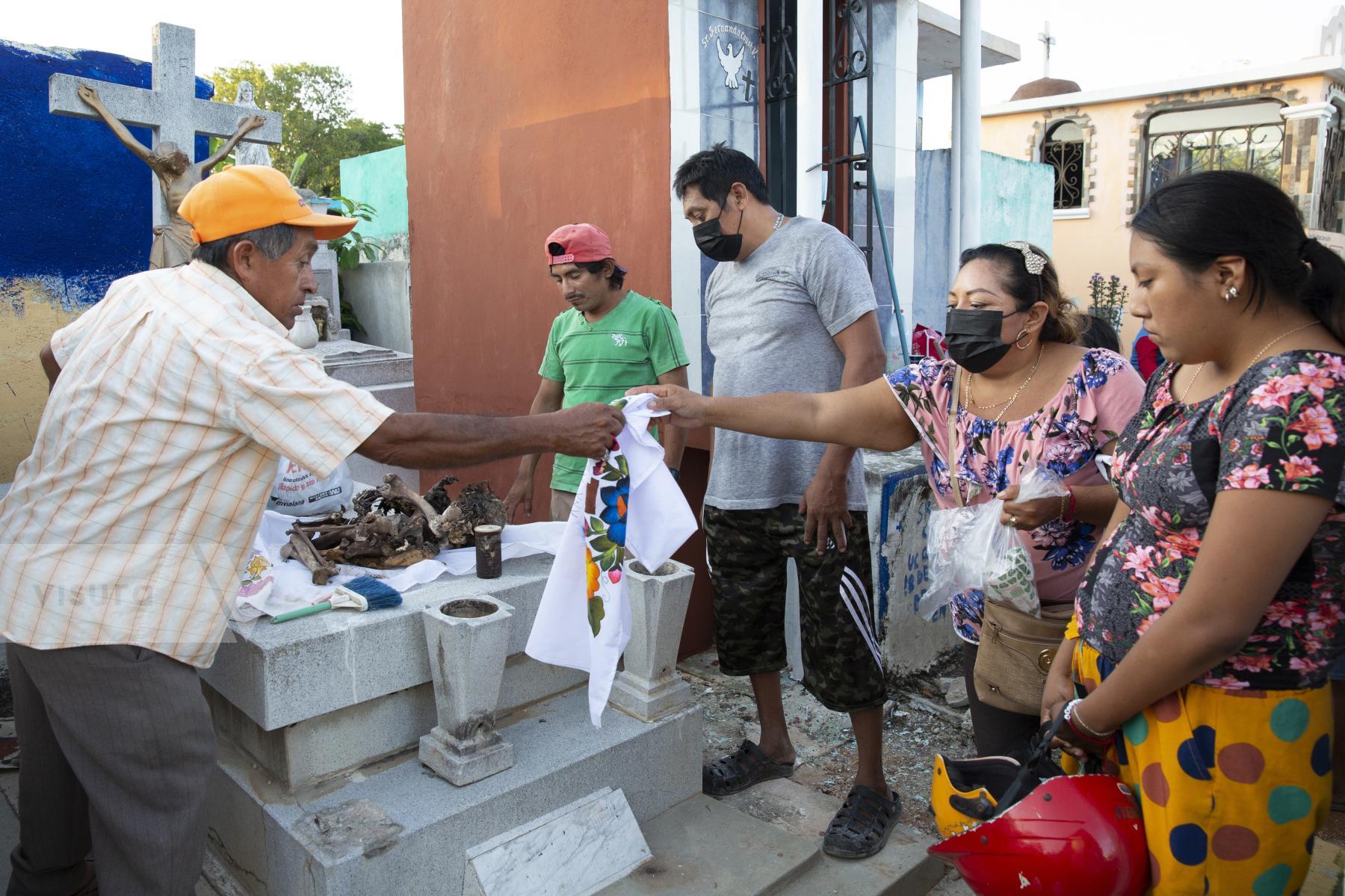
Caption:
Don Venancio Tuz Chi, one of the administrators of the Pomuch cemetery, cleaning the bones and skulls of a deceased relative of the Colli Ycauch family at the cemetery of Pomuch, Campeche state, Mexico on October 22, 2022. Don Venancio has been a hired bone cleaner for over twenty years, he is paid $1.50 per skeleton. Every year in preparation for Hanal Pixán, the Mayan Day of the Dead celebration, members of the Pomuch community in southeastern Mexico extract bones from their niches and carefully clean them – an ancestral tradition seen as a gesture of love and a way to get closer to deceased family members. This ritual, which in Mayan is known as Choo Ba’ak, can be done for the first time when a person has been dead for three years. Pomuch and a handful of other Mayan communities are believed to be the only places in the country where people clean the bones of the dead. Since 2017 this tradition is considered Cultural Heritage of the State of Campeche. Photograph by Bénédicte Desrus Pomuch Mexico
Don Venancio Tuz Chi, one of the administrators of the Pomuch cemetery, cleaning the bones and skulls of a deceased relative of the Colli Ycauch family at the cemetery of Pomuch, Campeche state, Mexico on October 22, 2022. Don Venancio has been a hired bone cleaner for over twenty years, he is paid $1.50 per skeleton. Every year in preparation for Hanal Pixán, the Mayan Day of the Dead celebration, members of the Pomuch community in southeastern Mexico extract bones from their niches and carefully clean them – an ancestral tradition seen as a gesture of love and a way to get closer to deceased family members. This ritual, which in Mayan is known as Choo Ba’ak, can be done for the first time when a person has been dead for three years. Pomuch and a handful of other Mayan communities are believed to be the only places in the country where people clean the bones of the dead. Since 2017 this tradition is considered Cultural Heritage of the State of Campeche. Photograph by Bénédicte Desrus Pomuch Mexico
Size: 3333h x 5000w
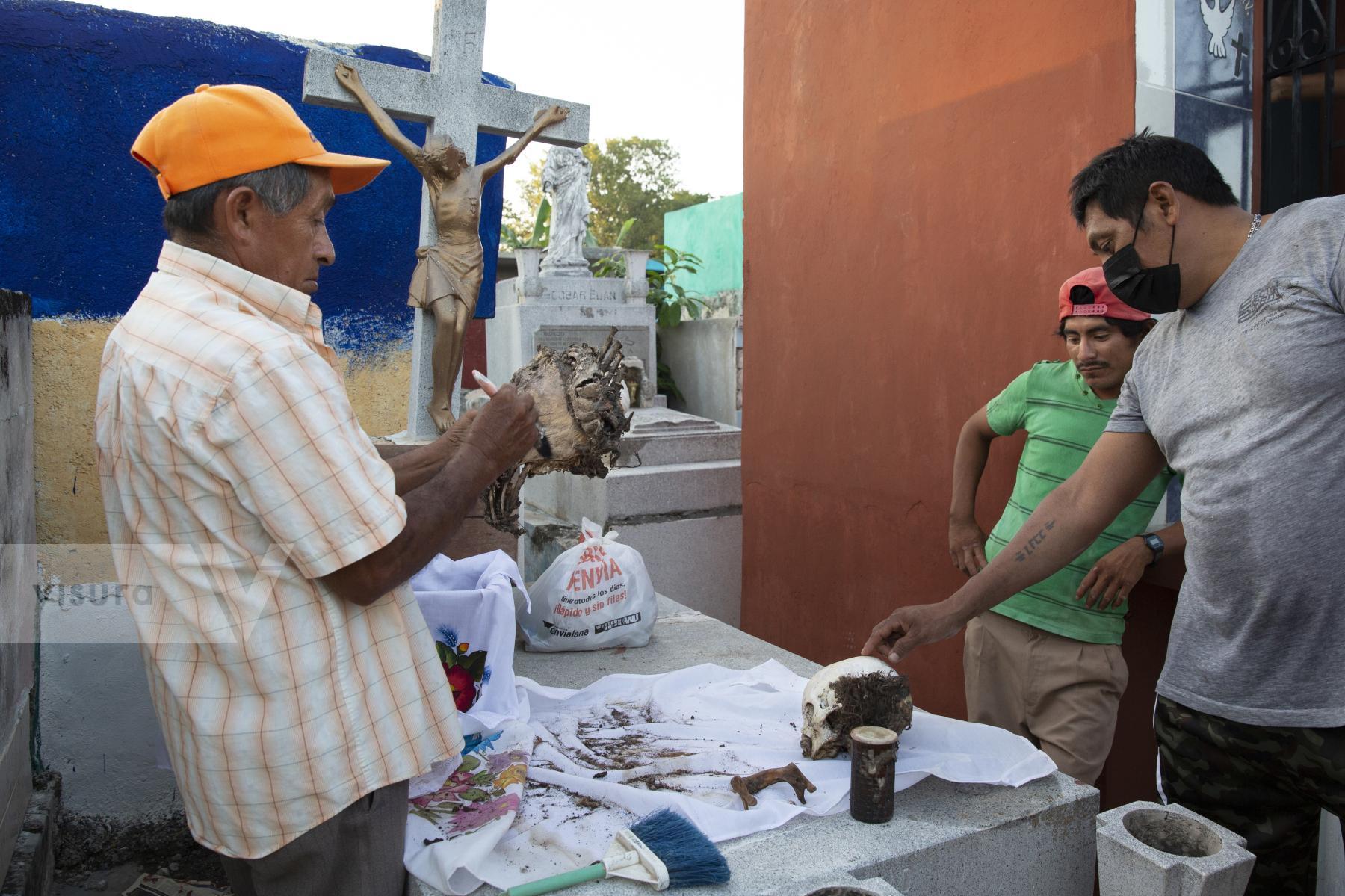
Caption:
Don Venancio Tuz Chi, one of the administrators of the Pomuch cemetery, cleaning the bones and skulls of a deceased relative of the Colli Ycauch family at the cemetery of Pomuch, Campeche state, Mexico on October 22, 2022. Don Venancio has been a hired bone cleaner for over twenty years, he is paid $1.50 per skeleton. Every year in preparation for Hanal Pixán, the Mayan Day of the Dead celebration, members of the Pomuch community in southeastern Mexico extract bones from their niches and carefully clean them – an ancestral tradition seen as a gesture of love and a way to get closer to deceased family members. This ritual, which in Mayan is known as Choo Ba’ak, can be done for the first time when a person has been dead for three years. Pomuch and a handful of other Mayan communities are believed to be the only places in the country where people clean the bones of the dead. Since 2017 this tradition is considered Cultural Heritage of the State of Campeche. Photograph by Bénédicte Desrus Pomuch Mexico
Don Venancio Tuz Chi, one of the administrators of the Pomuch cemetery, cleaning the bones and skulls of a deceased relative of the Colli Ycauch family at the cemetery of Pomuch, Campeche state, Mexico on October 22, 2022. Don Venancio has been a hired bone cleaner for over twenty years, he is paid $1.50 per skeleton. Every year in preparation for Hanal Pixán, the Mayan Day of the Dead celebration, members of the Pomuch community in southeastern Mexico extract bones from their niches and carefully clean them – an ancestral tradition seen as a gesture of love and a way to get closer to deceased family members. This ritual, which in Mayan is known as Choo Ba’ak, can be done for the first time when a person has been dead for three years. Pomuch and a handful of other Mayan communities are believed to be the only places in the country where people clean the bones of the dead. Since 2017 this tradition is considered Cultural Heritage of the State of Campeche. Photograph by Bénédicte Desrus Pomuch Mexico
Size: 3333h x 5000w
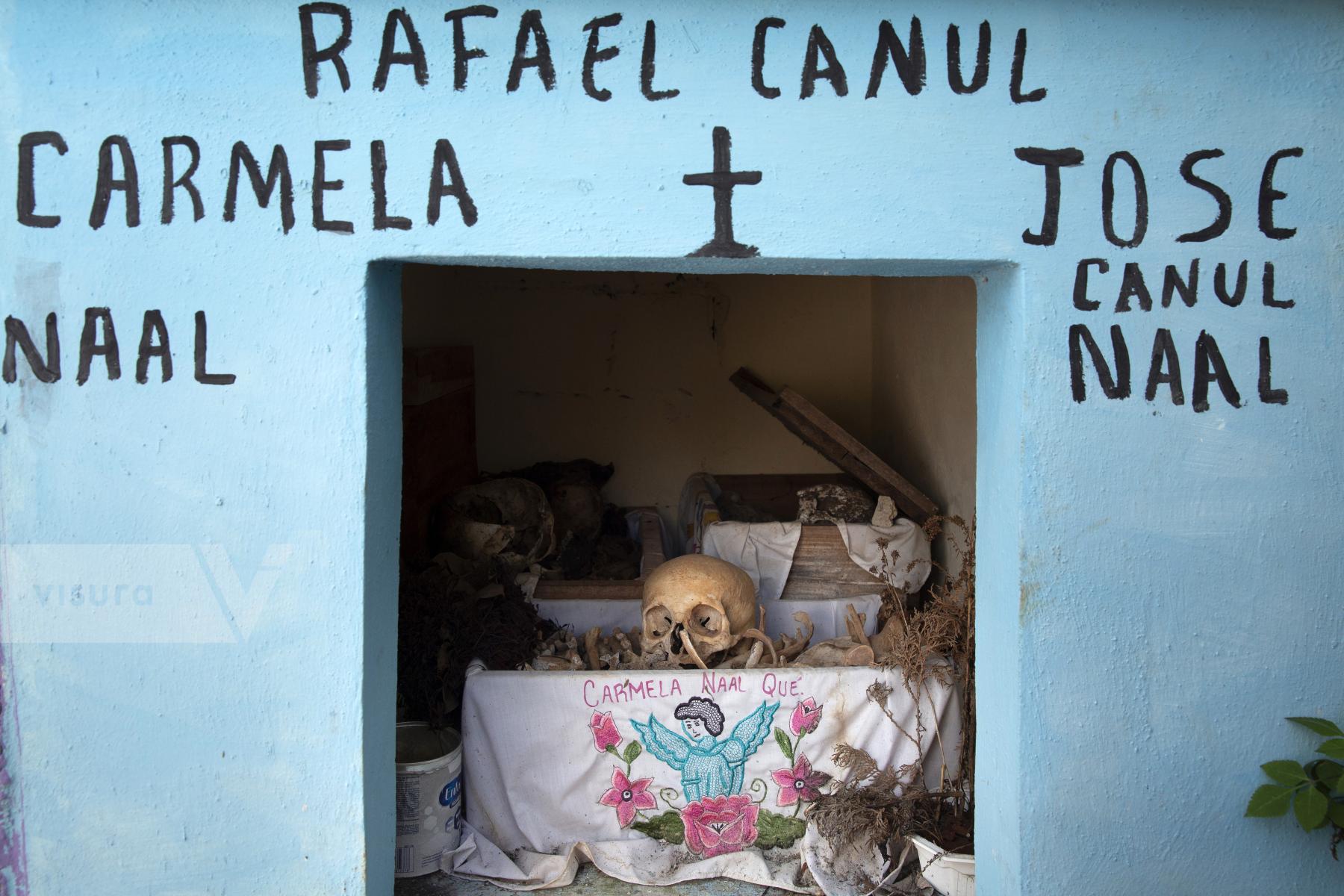
Caption:
Dried-up skulls and bones are seen wrapped in embroidered white tablecloths bearing the names of the deceased, and placed in wooden crates inside a niche at the cemetery in Pomuch, Campeche state, Mexico on October 22, 2022. Every year in preparation for Hanal Pixán, the Mayan Day of the Dead celebration, members of the Pomuch community in southeastern Mexico extract bones from their niches and carefully clean them – an ancestral tradition seen as a gesture of love and a way to get closer to deceased family members. This ritual, which in Mayan is known as Choo Ba’ak, can be done for the first time when a person has been dead for three years. Pomuch and a handful of other Mayan communities are believed to be the only places in the country where people clean the bones of the dead. Since 2017 this tradition is considered Cultural Heritage of the State of Campeche. Photograph by Bénédicte Desrus Pomuch Mexico
Dried-up skulls and bones are seen wrapped in embroidered white tablecloths bearing the names of the deceased, and placed in wooden crates inside a niche at the cemetery in Pomuch, Campeche state, Mexico on October 22, 2022. Every year in preparation for Hanal Pixán, the Mayan Day of the Dead celebration, members of the Pomuch community in southeastern Mexico extract bones from their niches and carefully clean them – an ancestral tradition seen as a gesture of love and a way to get closer to deceased family members. This ritual, which in Mayan is known as Choo Ba’ak, can be done for the first time when a person has been dead for three years. Pomuch and a handful of other Mayan communities are believed to be the only places in the country where people clean the bones of the dead. Since 2017 this tradition is considered Cultural Heritage of the State of Campeche. Photograph by Bénédicte Desrus Pomuch Mexico
Size: 3334h x 5000w

Caption:
Women clean the bones and skulls of their deceased relatives from the Kuk Pech family at the cemetery of Pomuch, Campeche state, Mexico on October 22, 2022. Every year in preparation for Hanal Pixán, the Mayan Day of the Dead celebration, members of the Pomuch community in southeastern Mexico extract bones from their niches and carefully clean them – an ancestral tradition seen as a gesture of love and a way to get closer to deceased family members. This ritual, which in Mayan is known as Choo Ba’ak, can be done for the first time when a person has been dead for three years. Pomuch and a handful of other Mayan communities are believed to be the only places in the country where people clean the bones of the dead. Since 2017 this tradition is considered Cultural Heritage of the State of Campeche. Photograph by Bénédicte Desrus Pomuch Mexico
Women clean the bones and skulls of their deceased relatives from the Kuk Pech family at the cemetery of Pomuch, Campeche state, Mexico on October 22, 2022. Every year in preparation for Hanal Pixán, the Mayan Day of the Dead celebration, members of the Pomuch community in southeastern Mexico extract bones from their niches and carefully clean them – an ancestral tradition seen as a gesture of love and a way to get closer to deceased family members. This ritual, which in Mayan is known as Choo Ba’ak, can be done for the first time when a person has been dead for three years. Pomuch and a handful of other Mayan communities are believed to be the only places in the country where people clean the bones of the dead. Since 2017 this tradition is considered Cultural Heritage of the State of Campeche. Photograph by Bénédicte Desrus Pomuch Mexico
Size: 3333h x 5000w
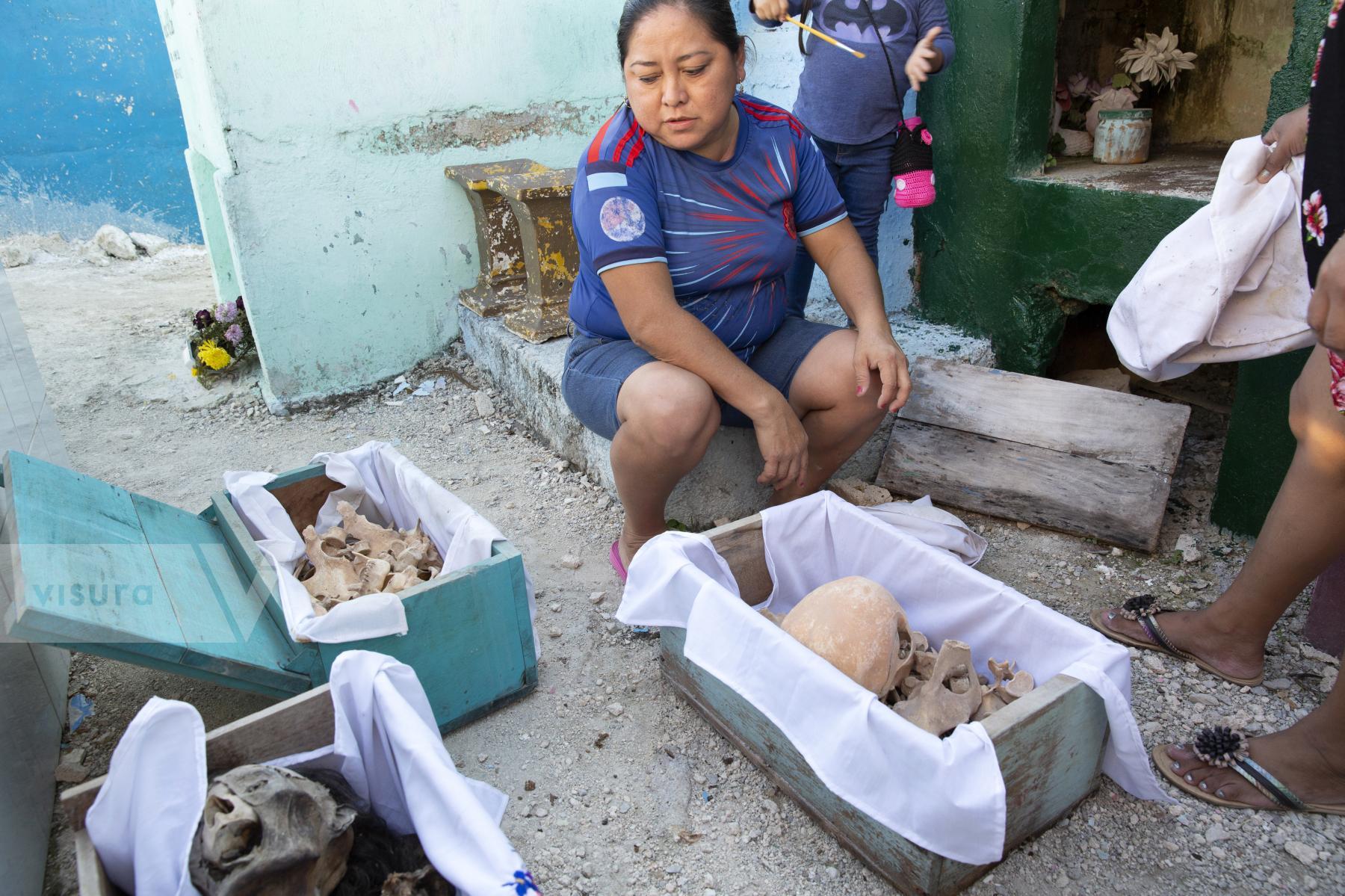
Caption:
Women clean the bones and skulls of their deceased relatives from the Kuk Pech family at the cemetery of Pomuch, Campeche state, Mexico on October 22, 2022. Every year in preparation for Hanal Pixán, the Mayan Day of the Dead celebration, members of the Pomuch community in southeastern Mexico extract bones from their niches and carefully clean them – an ancestral tradition seen as a gesture of love and a way to get closer to deceased family members. This ritual, which in Mayan is known as Choo Ba’ak, can be done for the first time when a person has been dead for three years. Pomuch and a handful of other Mayan communities are believed to be the only places in the country where people clean the bones of the dead. Since 2017 this tradition is considered Cultural Heritage of the State of Campeche. Photograph by Bénédicte Desrus Pomuch Mexico
Women clean the bones and skulls of their deceased relatives from the Kuk Pech family at the cemetery of Pomuch, Campeche state, Mexico on October 22, 2022. Every year in preparation for Hanal Pixán, the Mayan Day of the Dead celebration, members of the Pomuch community in southeastern Mexico extract bones from their niches and carefully clean them – an ancestral tradition seen as a gesture of love and a way to get closer to deceased family members. This ritual, which in Mayan is known as Choo Ba’ak, can be done for the first time when a person has been dead for three years. Pomuch and a handful of other Mayan communities are believed to be the only places in the country where people clean the bones of the dead. Since 2017 this tradition is considered Cultural Heritage of the State of Campeche. Photograph by Bénédicte Desrus Pomuch Mexico
Size: 3333h x 5000w

Caption:
A man arranges and paints a grave at the cemetery of Pomuch, Campeche state, Mexico on October 22, 2022. Every year in preparation for Hanal Pixán, the Mayan Day of the Dead celebration, members of the Pomuch community in southeastern Mexico extract bones from their niches and carefully clean them – an ancestral tradition seen as a gesture of love and a way to get closer to deceased family members. This ritual, which in Mayan is known as Choo Ba’ak, can be done for the first time when a person has been dead for three years. Pomuch and a handful of other Mayan communities are believed to be the only places in the country where people clean the bones of the dead. Since 2017 this tradition is considered Cultural Heritage of the State of Campeche. Photograph by Bénédicte Desrus Pomuch Mexico
A man arranges and paints a grave at the cemetery of Pomuch, Campeche state, Mexico on October 22, 2022. Every year in preparation for Hanal Pixán, the Mayan Day of the Dead celebration, members of the Pomuch community in southeastern Mexico extract bones from their niches and carefully clean them – an ancestral tradition seen as a gesture of love and a way to get closer to deceased family members. This ritual, which in Mayan is known as Choo Ba’ak, can be done for the first time when a person has been dead for three years. Pomuch and a handful of other Mayan communities are believed to be the only places in the country where people clean the bones of the dead. Since 2017 this tradition is considered Cultural Heritage of the State of Campeche. Photograph by Bénédicte Desrus Pomuch Mexico
Size: 3333h x 5000w

Caption:
Dried-up skulls and bones are seen wrapped in embroidered white tablecloths bearing the names of the deceased, and placed in wooden crates inside a niche at the cemetery in Pomuch, Campeche state, Mexico on October 22, 2022. Every year in preparation for Hanal Pixán, the Mayan Day of the Dead celebration, members of the Pomuch community in southeastern Mexico extract bones from their niches and carefully clean them – an ancestral tradition seen as a gesture of love and a way to get closer to deceased family members. This ritual, which in Mayan is known as Choo Ba’ak, can be done for the first time when a person has been dead for three years. Pomuch and a handful of other Mayan communities are believed to be the only places in the country where people clean the bones of the dead. Since 2017 this tradition is considered Cultural Heritage of the State of Campeche. Photograph by Bénédicte Desrus Pomuch Mexico
Dried-up skulls and bones are seen wrapped in embroidered white tablecloths bearing the names of the deceased, and placed in wooden crates inside a niche at the cemetery in Pomuch, Campeche state, Mexico on October 22, 2022. Every year in preparation for Hanal Pixán, the Mayan Day of the Dead celebration, members of the Pomuch community in southeastern Mexico extract bones from their niches and carefully clean them – an ancestral tradition seen as a gesture of love and a way to get closer to deceased family members. This ritual, which in Mayan is known as Choo Ba’ak, can be done for the first time when a person has been dead for three years. Pomuch and a handful of other Mayan communities are believed to be the only places in the country where people clean the bones of the dead. Since 2017 this tradition is considered Cultural Heritage of the State of Campeche. Photograph by Bénédicte Desrus Pomuch Mexico
Size: 3333h x 5000w
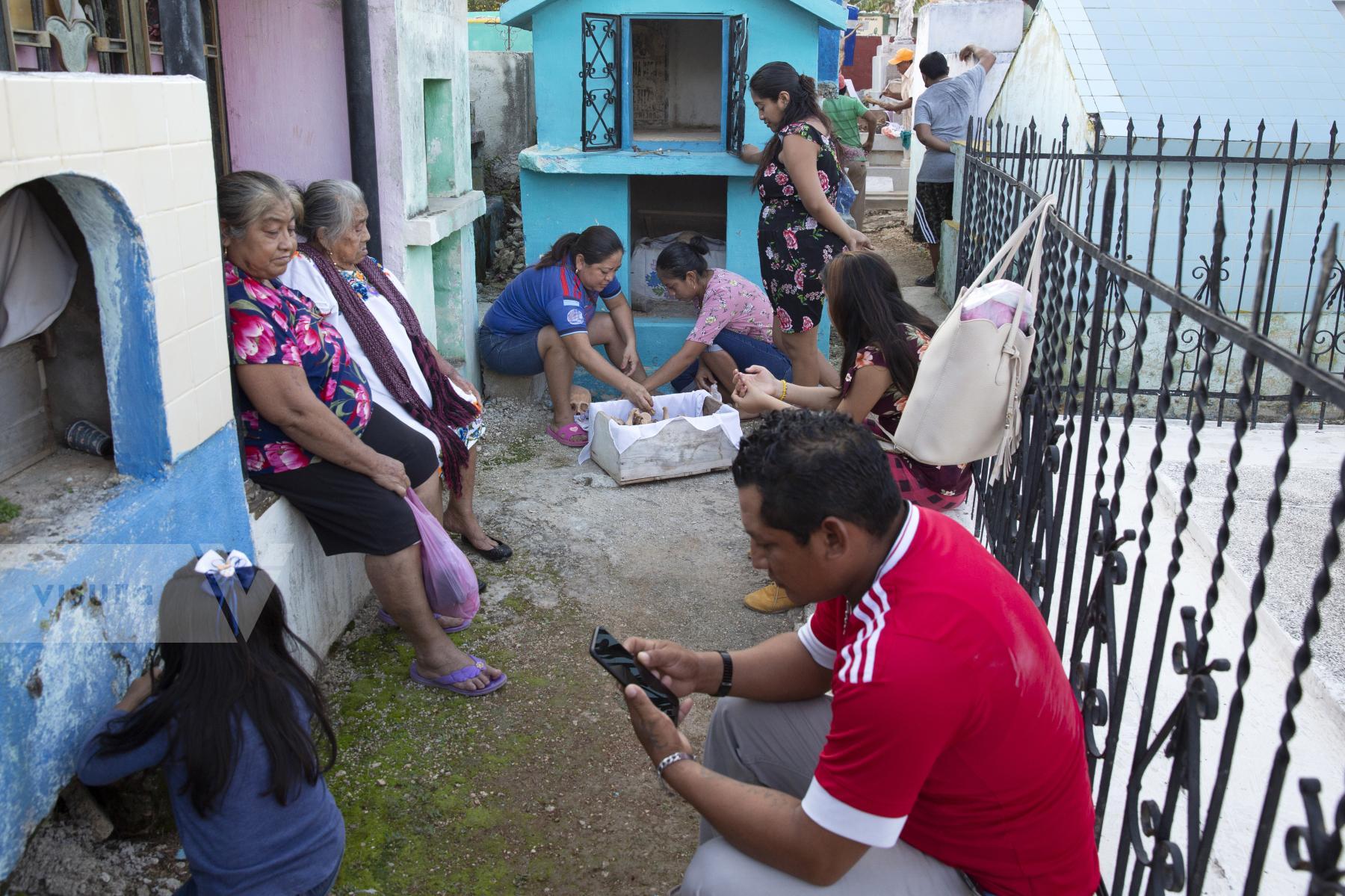
Caption:
Women clean the bones and skulls of their deceased relatives from the Uitz Poot family at the cemetery of Pomuch, Campeche state, Mexico on October 22, 2022. Every year in preparation for Hanal Pixán, the Mayan Day of the Dead celebration, members of the Pomuch community in southeastern Mexico extract bones from their niches and carefully clean them – an ancestral tradition seen as a gesture of love and a way to get closer to deceased family members. This ritual, which in Mayan is known as Choo Ba’ak, can be done for the first time when a person has been dead for three years. Pomuch and a handful of other Mayan communities are believed to be the only places in the country where people clean the bones of the dead. Since 2017 this tradition is considered Cultural Heritage of the State of Campeche. Photograph by Bénédicte Desrus Pomuch Mexico
Women clean the bones and skulls of their deceased relatives from the Uitz Poot family at the cemetery of Pomuch, Campeche state, Mexico on October 22, 2022. Every year in preparation for Hanal Pixán, the Mayan Day of the Dead celebration, members of the Pomuch community in southeastern Mexico extract bones from their niches and carefully clean them – an ancestral tradition seen as a gesture of love and a way to get closer to deceased family members. This ritual, which in Mayan is known as Choo Ba’ak, can be done for the first time when a person has been dead for three years. Pomuch and a handful of other Mayan communities are believed to be the only places in the country where people clean the bones of the dead. Since 2017 this tradition is considered Cultural Heritage of the State of Campeche. Photograph by Bénédicte Desrus Pomuch Mexico
Size: 3333h x 5000w
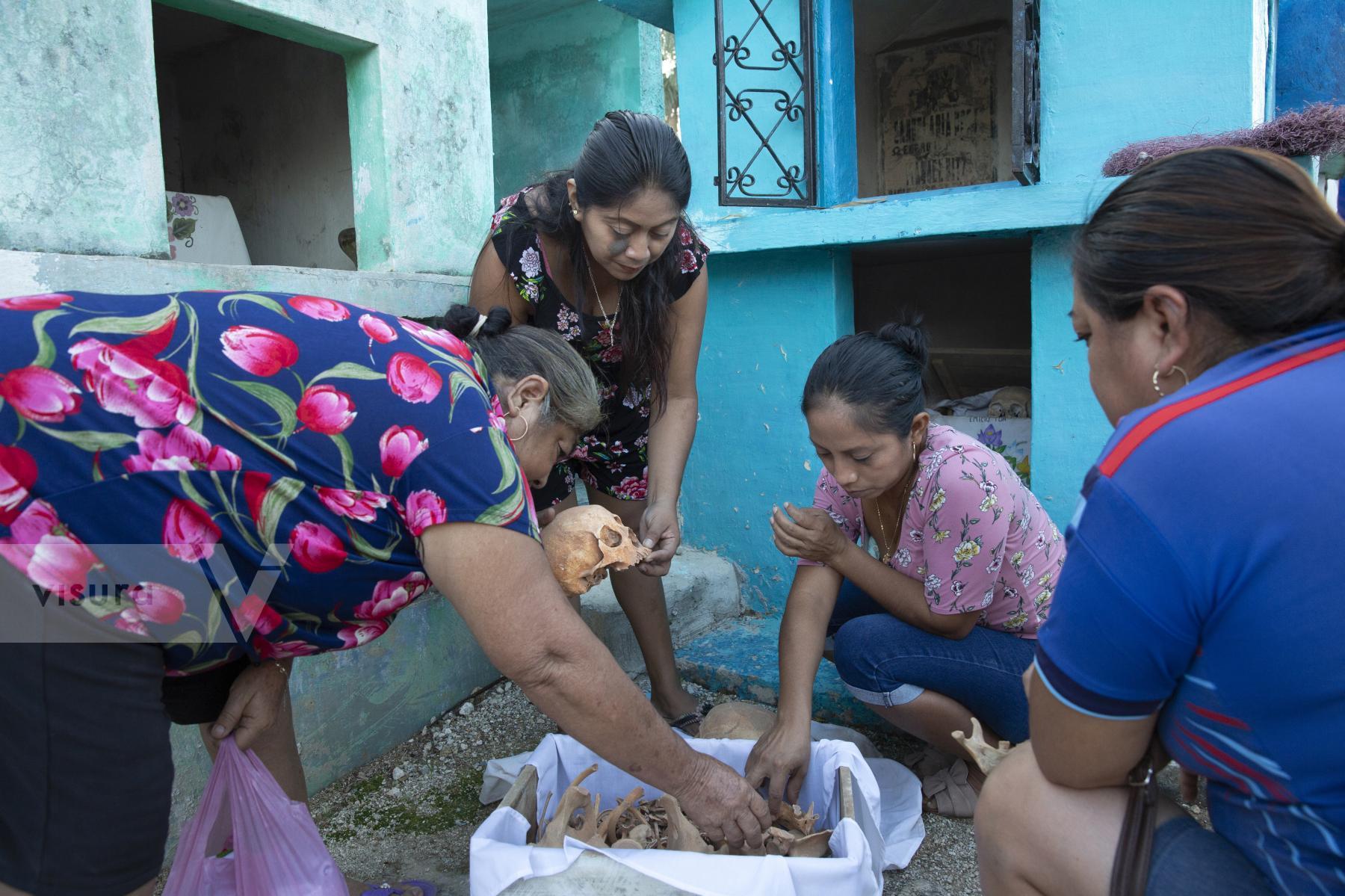
Caption:
Women clean the bones and skulls of their deceased relatives from the Uitz Poot family at the cemetery of Pomuch, Campeche state, Mexico on October 22, 2022. Every year in preparation for Hanal Pixán, the Mayan Day of the Dead celebration, members of the Pomuch community in southeastern Mexico extract bones from their niches and carefully clean them – an ancestral tradition seen as a gesture of love and a way to get closer to deceased family members. This ritual, which in Mayan is known as Choo Ba’ak, can be done for the first time when a person has been dead for three years. Pomuch and a handful of other Mayan communities are believed to be the only places in the country where people clean the bones of the dead. Since 2017 this tradition is considered Cultural Heritage of the State of Campeche. Photograph by Bénédicte Desrus Pomuch Mexico
Women clean the bones and skulls of their deceased relatives from the Uitz Poot family at the cemetery of Pomuch, Campeche state, Mexico on October 22, 2022. Every year in preparation for Hanal Pixán, the Mayan Day of the Dead celebration, members of the Pomuch community in southeastern Mexico extract bones from their niches and carefully clean them – an ancestral tradition seen as a gesture of love and a way to get closer to deceased family members. This ritual, which in Mayan is known as Choo Ba’ak, can be done for the first time when a person has been dead for three years. Pomuch and a handful of other Mayan communities are believed to be the only places in the country where people clean the bones of the dead. Since 2017 this tradition is considered Cultural Heritage of the State of Campeche. Photograph by Bénédicte Desrus Pomuch Mexico
Size: 3333h x 5000w
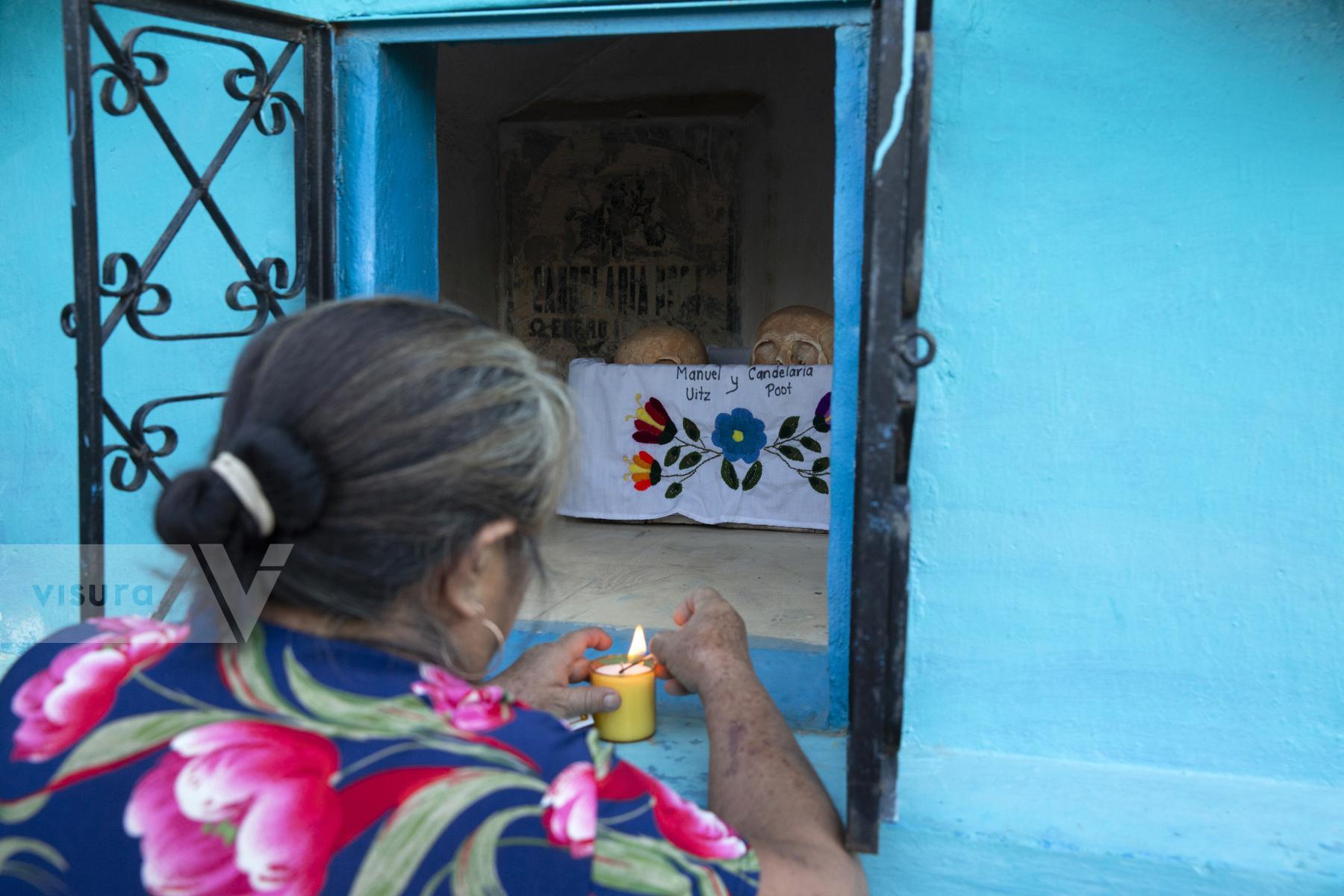
Caption:
A woman lighting a candle on the niche of her deceased grandparents from the Uitz Poot family at the cemetery of Pomuch, Campeche state, Mexico on October 22, 2022. Every year in preparation for Hanal Pixán, the Mayan Day of the Dead celebration, members of the Pomuch community in southeastern Mexico extract bones from their niches and carefully clean them – an ancestral tradition seen as a gesture of love and a way to get closer to deceased family members. This ritual, which in Mayan is known as Choo Ba’ak, can be done for the first time when a person has been dead for three years. Pomuch and a handful of other Mayan communities are believed to be the only places in the country where people clean the bones of the dead. Since 2017 this tradition is considered Cultural Heritage of the State of Campeche. Photograph by Bénédicte Desrus Pomuch Mexico
A woman lighting a candle on the niche of her deceased grandparents from the Uitz Poot family at the cemetery of Pomuch, Campeche state, Mexico on October 22, 2022. Every year in preparation for Hanal Pixán, the Mayan Day of the Dead celebration, members of the Pomuch community in southeastern Mexico extract bones from their niches and carefully clean them – an ancestral tradition seen as a gesture of love and a way to get closer to deceased family members. This ritual, which in Mayan is known as Choo Ba’ak, can be done for the first time when a person has been dead for three years. Pomuch and a handful of other Mayan communities are believed to be the only places in the country where people clean the bones of the dead. Since 2017 this tradition is considered Cultural Heritage of the State of Campeche. Photograph by Bénédicte Desrus Pomuch Mexico
Size: 3334h x 5000w
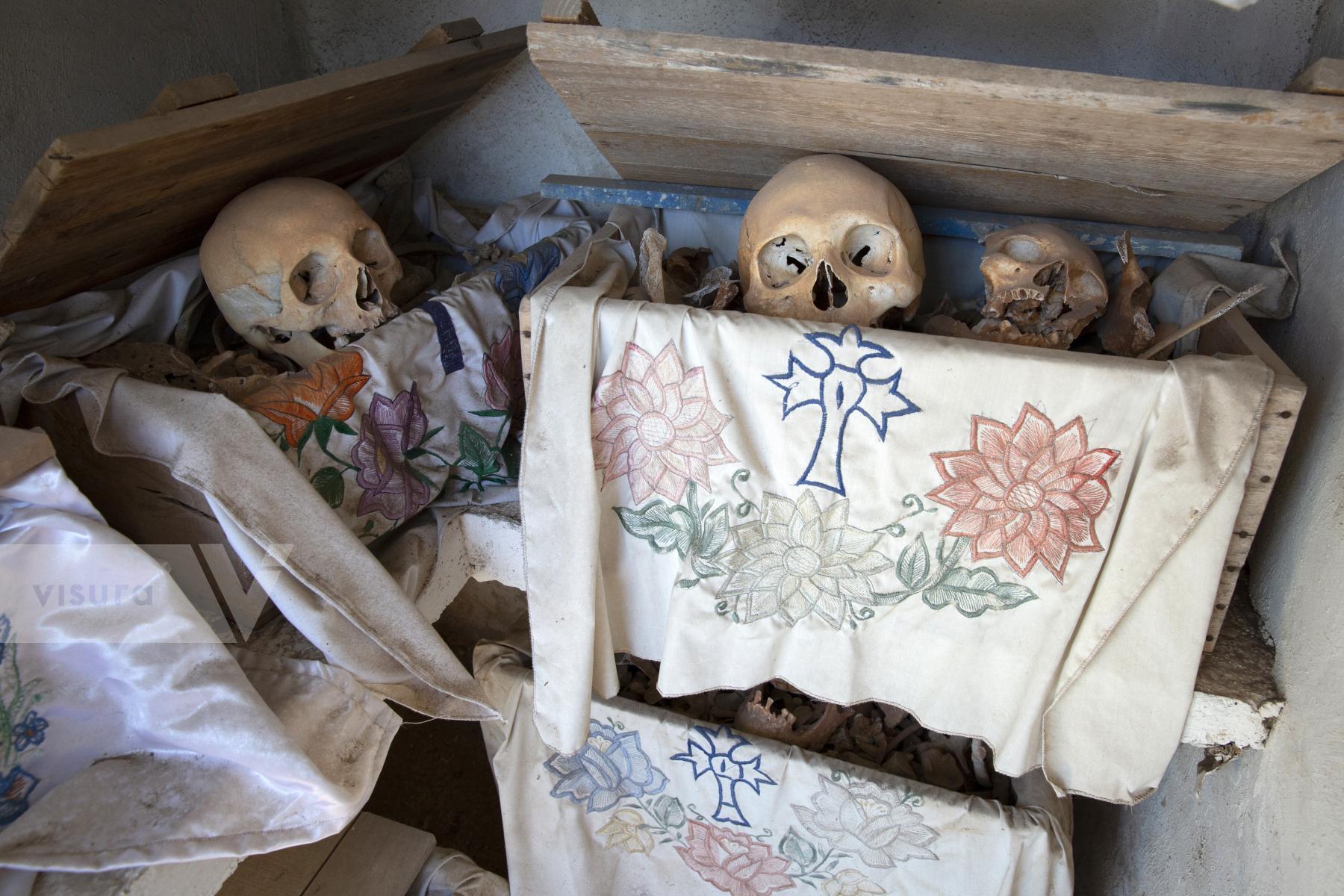
Caption:
Dried-up skulls and bones are seen wrapped in embroidered white tablecloths bearing the names of the deceased, and placed in wooden crates inside a niche at the cemetery in Pomuch, Campeche state, Mexico on October 22, 2022. Every year in preparation for Hanal Pixán, the Mayan Day of the Dead celebration, members of the Pomuch community in southeastern Mexico extract bones from their niches and carefully clean them – an ancestral tradition seen as a gesture of love and a way to get closer to deceased family members. This ritual, which in Mayan is known as Choo Ba’ak, can be done for the first time when a person has been dead for three years. Pomuch and a handful of other Mayan communities are believed to be the only places in the country where people clean the bones of the dead. Since 2017 this tradition is considered Cultural Heritage of the State of Campeche. Photograph by Bénédicte Desrus Pomuch Mexico
Dried-up skulls and bones are seen wrapped in embroidered white tablecloths bearing the names of the deceased, and placed in wooden crates inside a niche at the cemetery in Pomuch, Campeche state, Mexico on October 22, 2022. Every year in preparation for Hanal Pixán, the Mayan Day of the Dead celebration, members of the Pomuch community in southeastern Mexico extract bones from their niches and carefully clean them – an ancestral tradition seen as a gesture of love and a way to get closer to deceased family members. This ritual, which in Mayan is known as Choo Ba’ak, can be done for the first time when a person has been dead for three years. Pomuch and a handful of other Mayan communities are believed to be the only places in the country where people clean the bones of the dead. Since 2017 this tradition is considered Cultural Heritage of the State of Campeche. Photograph by Bénédicte Desrus Pomuch Mexico
Size: 3334h x 5000w
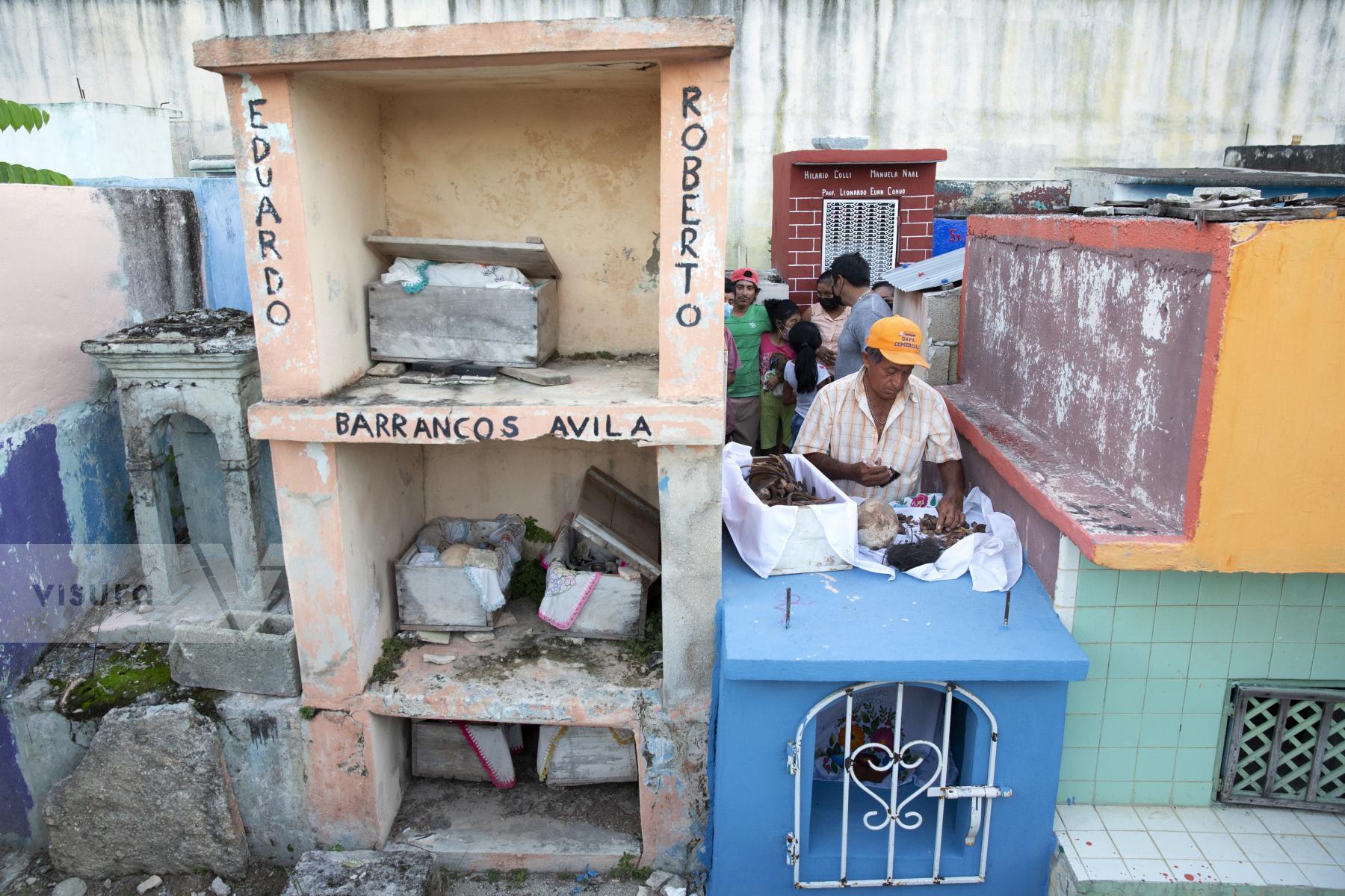
Caption:
Don Venancio Tuz Chi, one of the administrators of the Pomuch cemetery, cleaning the bones and skulls of a deceased relative of the Colli Ycauch family at the cemetery of Pomuch, Campeche state, Mexico on October 22, 2022. Don Venancio has been a hired bone cleaner for over twenty years, he is paid $1.50 per skeleton. Every year in preparation for Hanal Pixán, the Mayan Day of the Dead celebration, members of the Pomuch community in southeastern Mexico extract bones from their niches and carefully clean them – an ancestral tradition seen as a gesture of love and a way to get closer to deceased family members. This ritual, which in Mayan is known as Choo Ba’ak, can be done for the first time when a person has been dead for three years. Pomuch and a handful of other Mayan communities are believed to be the only places in the country where people clean the bones of the dead. Since 2017 this tradition is considered Cultural Heritage of the State of Campeche. Photograph by Bénédicte Desrus Pomuch Mexico
Don Venancio Tuz Chi, one of the administrators of the Pomuch cemetery, cleaning the bones and skulls of a deceased relative of the Colli Ycauch family at the cemetery of Pomuch, Campeche state, Mexico on October 22, 2022. Don Venancio has been a hired bone cleaner for over twenty years, he is paid $1.50 per skeleton. Every year in preparation for Hanal Pixán, the Mayan Day of the Dead celebration, members of the Pomuch community in southeastern Mexico extract bones from their niches and carefully clean them – an ancestral tradition seen as a gesture of love and a way to get closer to deceased family members. This ritual, which in Mayan is known as Choo Ba’ak, can be done for the first time when a person has been dead for three years. Pomuch and a handful of other Mayan communities are believed to be the only places in the country where people clean the bones of the dead. Since 2017 this tradition is considered Cultural Heritage of the State of Campeche. Photograph by Bénédicte Desrus Pomuch Mexico
Size: 3333h x 5000w
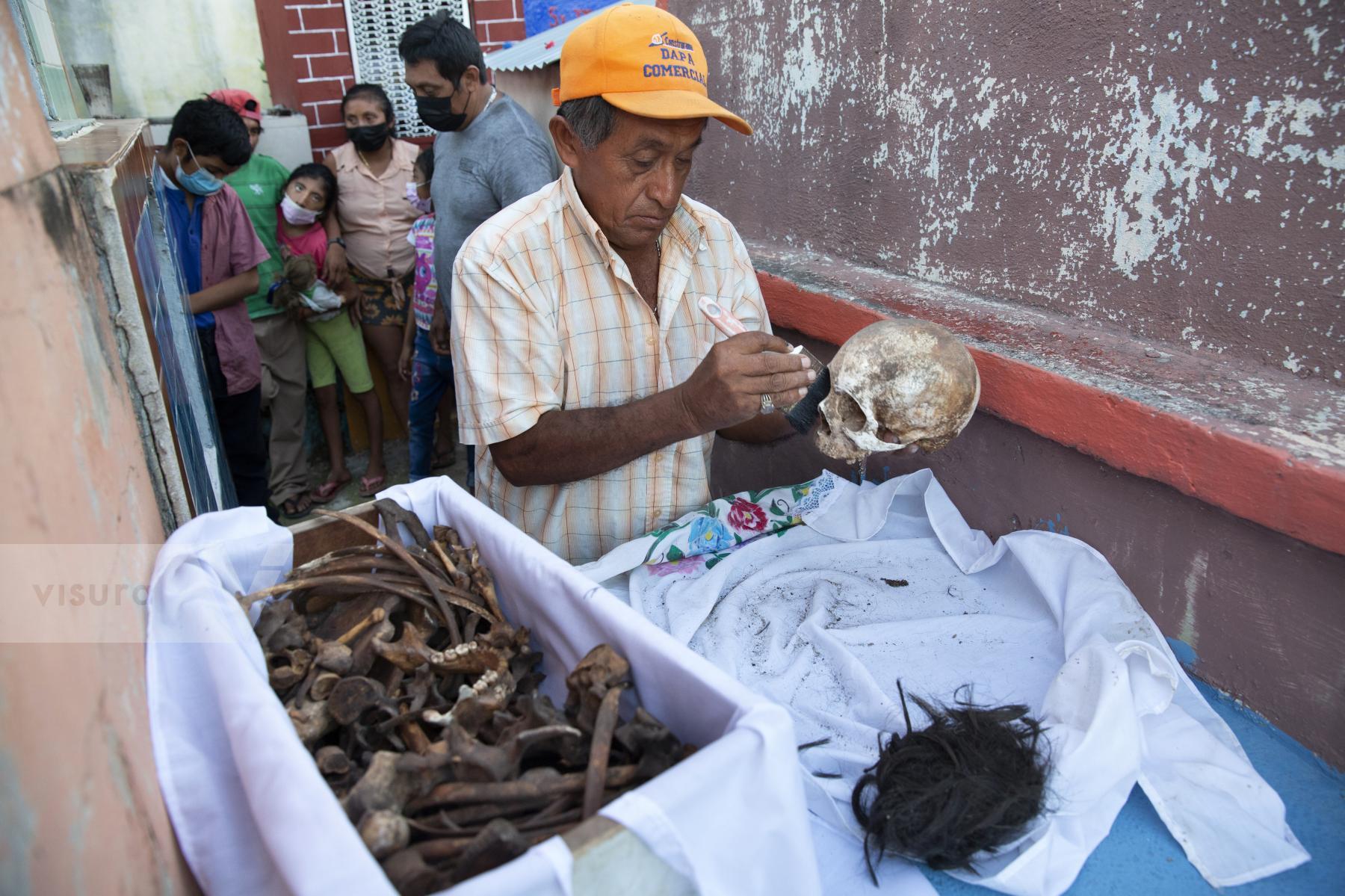
Caption:
Don Venancio Tuz Chi, one of the administrators of the Pomuch cemetery, cleaning the bones and skulls of a deceased relative of the Colli Ycauch family at the cemetery of Pomuch, Campeche state, Mexico on October 22, 2022. Don Venancio has been a hired bone cleaner for over twenty years, he is paid $1.50 per skeleton. Every year in preparation for Hanal Pixán, the Mayan Day of the Dead celebration, members of the Pomuch community in southeastern Mexico extract bones from their niches and carefully clean them – an ancestral tradition seen as a gesture of love and a way to get closer to deceased family members. This ritual, which in Mayan is known as Choo Ba’ak, can be done for the first time when a person has been dead for three years. Pomuch and a handful of other Mayan communities are believed to be the only places in the country where people clean the bones of the dead. Since 2017 this tradition is considered Cultural Heritage of the State of Campeche. Photograph by Bénédicte Desrus Pomuch Mexico
Don Venancio Tuz Chi, one of the administrators of the Pomuch cemetery, cleaning the bones and skulls of a deceased relative of the Colli Ycauch family at the cemetery of Pomuch, Campeche state, Mexico on October 22, 2022. Don Venancio has been a hired bone cleaner for over twenty years, he is paid $1.50 per skeleton. Every year in preparation for Hanal Pixán, the Mayan Day of the Dead celebration, members of the Pomuch community in southeastern Mexico extract bones from their niches and carefully clean them – an ancestral tradition seen as a gesture of love and a way to get closer to deceased family members. This ritual, which in Mayan is known as Choo Ba’ak, can be done for the first time when a person has been dead for three years. Pomuch and a handful of other Mayan communities are believed to be the only places in the country where people clean the bones of the dead. Since 2017 this tradition is considered Cultural Heritage of the State of Campeche. Photograph by Bénédicte Desrus Pomuch Mexico
Size: 3333h x 5000w
Purchase License
Editorial License
Rights Managed
Buy Now
Commercial License
Rights Managed
Buy Now
Request a special price or selection: Custom request
CHOO BA'AK • The Mayan bone cleaning ritual in Pomuch, Mexico.
Story
Includes 16 images
Credit: Bénédicte Desrus via Visura
Asset ID: VA86528
Caption: Available
Copyright: © Bénédicte Desrus, 2024
Collection:
Topics:
Asset ID: VA86528
Caption: Available
Copyright: © Bénédicte Desrus, 2024
Collection:
Topics:
Bénédicte Desrus

Don Venancio Tuz Chi, one of the administrators of the Pomuch cemetery, pulling a box with the remains of two deceased relatives of the Cauich Haas family at the cemetery of Pomuch, Campeche state, Mexico on October 22, 2022. Don Venancio has been a hired bone cleaner for over twenty years, he is paid $1.50 per skeleton. Every year in preparation for Hanal Pixán, the Mayan Day of the Dead celebration, members of the Pomuch community in southeastern Mexico extract bones from their niches and carefully clean them – an ancestral tradition seen as a gesture of love and a way to get closer to deceased family members. This ritual, which in Mayan is known as Choo Ba’ak, can be done for the first time when a person has been dead for three years. Pomuch and a handful of other Mayan communities are believed to be the only places in the country where people clean the bones of the dead. Since 2017 this tradition is considered Cultural Heritage of the State of Campeche. Photograph by Bénédicte Desrus Pomuch Mexico

Dried-up skulls and bones are seen wrapped in embroidered white tablecloths bearing the names of the deceased, and placed in wooden crates inside a niche at the cemetery in Pomuch, Campeche state, Mexico on October 22, 2022. Every year in preparation for Hanal Pixán, the Mayan Day of the Dead celebration, members of the Pomuch community in southeastern Mexico extract bones from their niches and carefully clean them – an ancestral tradition seen as a gesture of love and a way to get closer to deceased family members. This ritual, which in Mayan is known as Choo Ba’ak, can be done for the first time when a person has been dead for three years. Pomuch and a handful of other Mayan communities are believed to be the only places in the country where people clean the bones of the dead. Since 2017 this tradition is considered Cultural Heritage of the State of Campeche. Photograph by Bénédicte Desrus Pomuch Mexico

The entrance of the Pomuch Cemetery in Pomuch, Campeche state, Mexico on October 22, 2022. Every year in preparation for Hanal Pixán, the Mayan Day of the Dead celebration, members of the Pomuch community in southeastern Mexico extract bones from their niches and carefully clean them – an ancestral tradition seen as a gesture of love and a way to get closer to deceased family members. This ritual, which in Mayan is known as Choo Ba’ak, can be done for the first time when a person has been dead for three years. Pomuch and a handful of other Mayan communities are believed to be the only places in the country where people clean the bones of the dead. Since 2017 this tradition is considered Cultural Heritage of the State of Campeche. Photograph by Bénédicte Desrus Pomuch Mexico

Don Venancio Tuz Chi, one of the administrators of the Pomuch cemetery, cleaning the bones and skulls of a deceased relative of the Colli Ycauch family at the cemetery of Pomuch, Campeche state, Mexico on October 22, 2022. Don Venancio has been a hired bone cleaner for over twenty years, he is paid $1.50 per skeleton. Every year in preparation for Hanal Pixán, the Mayan Day of the Dead celebration, members of the Pomuch community in southeastern Mexico extract bones from their niches and carefully clean them – an ancestral tradition seen as a gesture of love and a way to get closer to deceased family members. This ritual, which in Mayan is known as Choo Ba’ak, can be done for the first time when a person has been dead for three years. Pomuch and a handful of other Mayan communities are believed to be the only places in the country where people clean the bones of the dead. Since 2017 this tradition is considered Cultural Heritage of the State of Campeche. Photograph by Bénédicte Desrus Pomuch Mexico

Don Venancio Tuz Chi, one of the administrators of the Pomuch cemetery, cleaning the bones and skulls of a deceased relative of the Colli Ycauch family at the cemetery of Pomuch, Campeche state, Mexico on October 22, 2022. Don Venancio has been a hired bone cleaner for over twenty years, he is paid $1.50 per skeleton. Every year in preparation for Hanal Pixán, the Mayan Day of the Dead celebration, members of the Pomuch community in southeastern Mexico extract bones from their niches and carefully clean them – an ancestral tradition seen as a gesture of love and a way to get closer to deceased family members. This ritual, which in Mayan is known as Choo Ba’ak, can be done for the first time when a person has been dead for three years. Pomuch and a handful of other Mayan communities are believed to be the only places in the country where people clean the bones of the dead. Since 2017 this tradition is considered Cultural Heritage of the State of Campeche. Photograph by Bénédicte Desrus Pomuch Mexico

Dried-up skulls and bones are seen wrapped in embroidered white tablecloths bearing the names of the deceased, and placed in wooden crates inside a niche at the cemetery in Pomuch, Campeche state, Mexico on October 22, 2022. Every year in preparation for Hanal Pixán, the Mayan Day of the Dead celebration, members of the Pomuch community in southeastern Mexico extract bones from their niches and carefully clean them – an ancestral tradition seen as a gesture of love and a way to get closer to deceased family members. This ritual, which in Mayan is known as Choo Ba’ak, can be done for the first time when a person has been dead for three years. Pomuch and a handful of other Mayan communities are believed to be the only places in the country where people clean the bones of the dead. Since 2017 this tradition is considered Cultural Heritage of the State of Campeche. Photograph by Bénédicte Desrus Pomuch Mexico

Women clean the bones and skulls of their deceased relatives from the Kuk Pech family at the cemetery of Pomuch, Campeche state, Mexico on October 22, 2022. Every year in preparation for Hanal Pixán, the Mayan Day of the Dead celebration, members of the Pomuch community in southeastern Mexico extract bones from their niches and carefully clean them – an ancestral tradition seen as a gesture of love and a way to get closer to deceased family members. This ritual, which in Mayan is known as Choo Ba’ak, can be done for the first time when a person has been dead for three years. Pomuch and a handful of other Mayan communities are believed to be the only places in the country where people clean the bones of the dead. Since 2017 this tradition is considered Cultural Heritage of the State of Campeche. Photograph by Bénédicte Desrus Pomuch Mexico

Women clean the bones and skulls of their deceased relatives from the Kuk Pech family at the cemetery of Pomuch, Campeche state, Mexico on October 22, 2022. Every year in preparation for Hanal Pixán, the Mayan Day of the Dead celebration, members of the Pomuch community in southeastern Mexico extract bones from their niches and carefully clean them – an ancestral tradition seen as a gesture of love and a way to get closer to deceased family members. This ritual, which in Mayan is known as Choo Ba’ak, can be done for the first time when a person has been dead for three years. Pomuch and a handful of other Mayan communities are believed to be the only places in the country where people clean the bones of the dead. Since 2017 this tradition is considered Cultural Heritage of the State of Campeche. Photograph by Bénédicte Desrus Pomuch Mexico

A man arranges and paints a grave at the cemetery of Pomuch, Campeche state, Mexico on October 22, 2022. Every year in preparation for Hanal Pixán, the Mayan Day of the Dead celebration, members of the Pomuch community in southeastern Mexico extract bones from their niches and carefully clean them – an ancestral tradition seen as a gesture of love and a way to get closer to deceased family members. This ritual, which in Mayan is known as Choo Ba’ak, can be done for the first time when a person has been dead for three years. Pomuch and a handful of other Mayan communities are believed to be the only places in the country where people clean the bones of the dead. Since 2017 this tradition is considered Cultural Heritage of the State of Campeche. Photograph by Bénédicte Desrus Pomuch Mexico

Dried-up skulls and bones are seen wrapped in embroidered white tablecloths bearing the names of the deceased, and placed in wooden crates inside a niche at the cemetery in Pomuch, Campeche state, Mexico on October 22, 2022. Every year in preparation for Hanal Pixán, the Mayan Day of the Dead celebration, members of the Pomuch community in southeastern Mexico extract bones from their niches and carefully clean them – an ancestral tradition seen as a gesture of love and a way to get closer to deceased family members. This ritual, which in Mayan is known as Choo Ba’ak, can be done for the first time when a person has been dead for three years. Pomuch and a handful of other Mayan communities are believed to be the only places in the country where people clean the bones of the dead. Since 2017 this tradition is considered Cultural Heritage of the State of Campeche. Photograph by Bénédicte Desrus Pomuch Mexico

Women clean the bones and skulls of their deceased relatives from the Uitz Poot family at the cemetery of Pomuch, Campeche state, Mexico on October 22, 2022. Every year in preparation for Hanal Pixán, the Mayan Day of the Dead celebration, members of the Pomuch community in southeastern Mexico extract bones from their niches and carefully clean them – an ancestral tradition seen as a gesture of love and a way to get closer to deceased family members. This ritual, which in Mayan is known as Choo Ba’ak, can be done for the first time when a person has been dead for three years. Pomuch and a handful of other Mayan communities are believed to be the only places in the country where people clean the bones of the dead. Since 2017 this tradition is considered Cultural Heritage of the State of Campeche. Photograph by Bénédicte Desrus Pomuch Mexico

Women clean the bones and skulls of their deceased relatives from the Uitz Poot family at the cemetery of Pomuch, Campeche state, Mexico on October 22, 2022. Every year in preparation for Hanal Pixán, the Mayan Day of the Dead celebration, members of the Pomuch community in southeastern Mexico extract bones from their niches and carefully clean them – an ancestral tradition seen as a gesture of love and a way to get closer to deceased family members. This ritual, which in Mayan is known as Choo Ba’ak, can be done for the first time when a person has been dead for three years. Pomuch and a handful of other Mayan communities are believed to be the only places in the country where people clean the bones of the dead. Since 2017 this tradition is considered Cultural Heritage of the State of Campeche. Photograph by Bénédicte Desrus Pomuch Mexico

A woman lighting a candle on the niche of her deceased grandparents from the Uitz Poot family at the cemetery of Pomuch, Campeche state, Mexico on October 22, 2022. Every year in preparation for Hanal Pixán, the Mayan Day of the Dead celebration, members of the Pomuch community in southeastern Mexico extract bones from their niches and carefully clean them – an ancestral tradition seen as a gesture of love and a way to get closer to deceased family members. This ritual, which in Mayan is known as Choo Ba’ak, can be done for the first time when a person has been dead for three years. Pomuch and a handful of other Mayan communities are believed to be the only places in the country where people clean the bones of the dead. Since 2017 this tradition is considered Cultural Heritage of the State of Campeche. Photograph by Bénédicte Desrus Pomuch Mexico

Dried-up skulls and bones are seen wrapped in embroidered white tablecloths bearing the names of the deceased, and placed in wooden crates inside a niche at the cemetery in Pomuch, Campeche state, Mexico on October 22, 2022. Every year in preparation for Hanal Pixán, the Mayan Day of the Dead celebration, members of the Pomuch community in southeastern Mexico extract bones from their niches and carefully clean them – an ancestral tradition seen as a gesture of love and a way to get closer to deceased family members. This ritual, which in Mayan is known as Choo Ba’ak, can be done for the first time when a person has been dead for three years. Pomuch and a handful of other Mayan communities are believed to be the only places in the country where people clean the bones of the dead. Since 2017 this tradition is considered Cultural Heritage of the State of Campeche. Photograph by Bénédicte Desrus Pomuch Mexico

Don Venancio Tuz Chi, one of the administrators of the Pomuch cemetery, cleaning the bones and skulls of a deceased relative of the Colli Ycauch family at the cemetery of Pomuch, Campeche state, Mexico on October 22, 2022. Don Venancio has been a hired bone cleaner for over twenty years, he is paid $1.50 per skeleton. Every year in preparation for Hanal Pixán, the Mayan Day of the Dead celebration, members of the Pomuch community in southeastern Mexico extract bones from their niches and carefully clean them – an ancestral tradition seen as a gesture of love and a way to get closer to deceased family members. This ritual, which in Mayan is known as Choo Ba’ak, can be done for the first time when a person has been dead for three years. Pomuch and a handful of other Mayan communities are believed to be the only places in the country where people clean the bones of the dead. Since 2017 this tradition is considered Cultural Heritage of the State of Campeche. Photograph by Bénédicte Desrus Pomuch Mexico

Don Venancio Tuz Chi, one of the administrators of the Pomuch cemetery, cleaning the bones and skulls of a deceased relative of the Colli Ycauch family at the cemetery of Pomuch, Campeche state, Mexico on October 22, 2022. Don Venancio has been a hired bone cleaner for over twenty years, he is paid $1.50 per skeleton. Every year in preparation for Hanal Pixán, the Mayan Day of the Dead celebration, members of the Pomuch community in southeastern Mexico extract bones from their niches and carefully clean them – an ancestral tradition seen as a gesture of love and a way to get closer to deceased family members. This ritual, which in Mayan is known as Choo Ba’ak, can be done for the first time when a person has been dead for three years. Pomuch and a handful of other Mayan communities are believed to be the only places in the country where people clean the bones of the dead. Since 2017 this tradition is considered Cultural Heritage of the State of Campeche. Photograph by Bénédicte Desrus Pomuch Mexico
